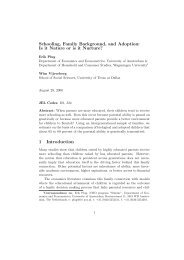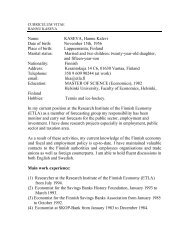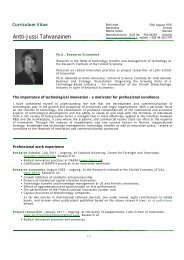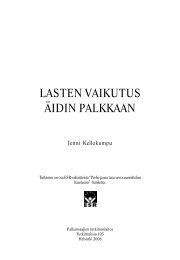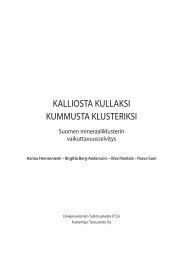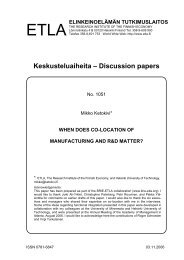Sergey Boltramovich, Grigory Dudarev, and Vladimir Gorelov ... - Etla
Sergey Boltramovich, Grigory Dudarev, and Vladimir Gorelov ... - Etla
Sergey Boltramovich, Grigory Dudarev, and Vladimir Gorelov ... - Etla
You also want an ePaper? Increase the reach of your titles
YUMPU automatically turns print PDFs into web optimized ePapers that Google loves.
27<br />
There are prospects for a substantial increase in the share of nonferrous<br />
metallurgy in the Republic of Komi, provided by the development<br />
of a major bauxite deposit already started in the region, as well as<br />
by the possible construction of an alumina-<strong>and</strong>-aluminum plant.<br />
3.5 Current Cluster Development Macro-trends in the<br />
World<br />
As a result of the closed economy of the USSR, metallurgy <strong>and</strong> metalworking<br />
companies did not take existing global trends into consideration<br />
when they planned their future development in the Soviet period.<br />
During the 1990s, the situation changed, <strong>and</strong> Russian enterprises<br />
started to work mostly for export, so now they have to consider the<br />
problems of the sector’s development on a global scale. It is especially<br />
important in an open economy, where international macro-trends inevitably<br />
influence domestic markets. According to experts, the major<br />
macro-trends, which determine the development of the international<br />
metal cluster include the following:<br />
1. Continuing growth of metal consumption in the world<br />
The consumption growth rate has slowed down, compared to the period<br />
from 1960 through the 1980s, but growth itself continues. A substantial<br />
degree of substitution of metals by other types of construction <strong>and</strong> technological<br />
materials (primarily, plastics) is not expected in the near future.<br />
2. Cyclical nature of metal products consumption<br />
Together with the overall growth in metal consumption, there are<br />
marked stages of a more intense increase in consumption during periods<br />
of economic growth, <strong>and</strong> stages of recession during periods of economic<br />
crises. For instance, the Asian financial crisis of 1998 triggered an overall<br />
decline in metal consumption, primarily because of shrinking Asian-<br />
Pacific markets.<br />
3. Growing diversification in metal products consumption<br />
As a result of intense development in new high-tech industries (radioelectronics,<br />
vehicle manufacturing, aerospace technologies, etc.), consumers<br />
of metal products in developed countries dem<strong>and</strong> newer <strong>and</strong> a<br />
greater variety of products.<br />
4. Differentiated development of metal-products markets<br />
Over the last few decades, in addition to the traditional markets of Western<br />
Europe <strong>and</strong> North America, major growth rates were seen in South-<br />
East Asia, which at present is the most significant market for products of



